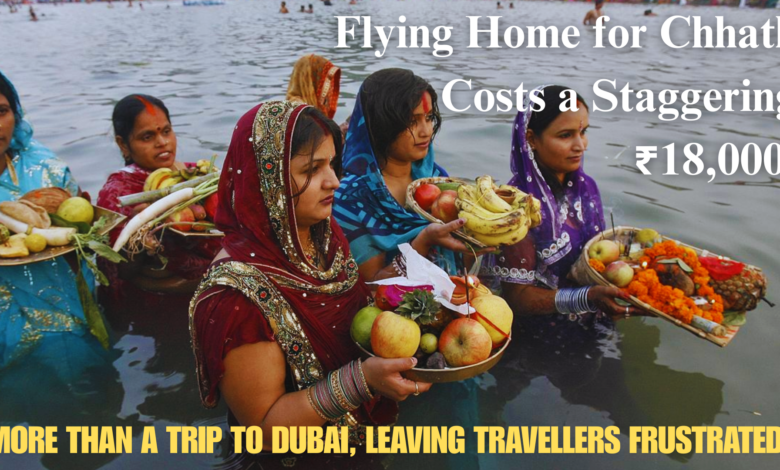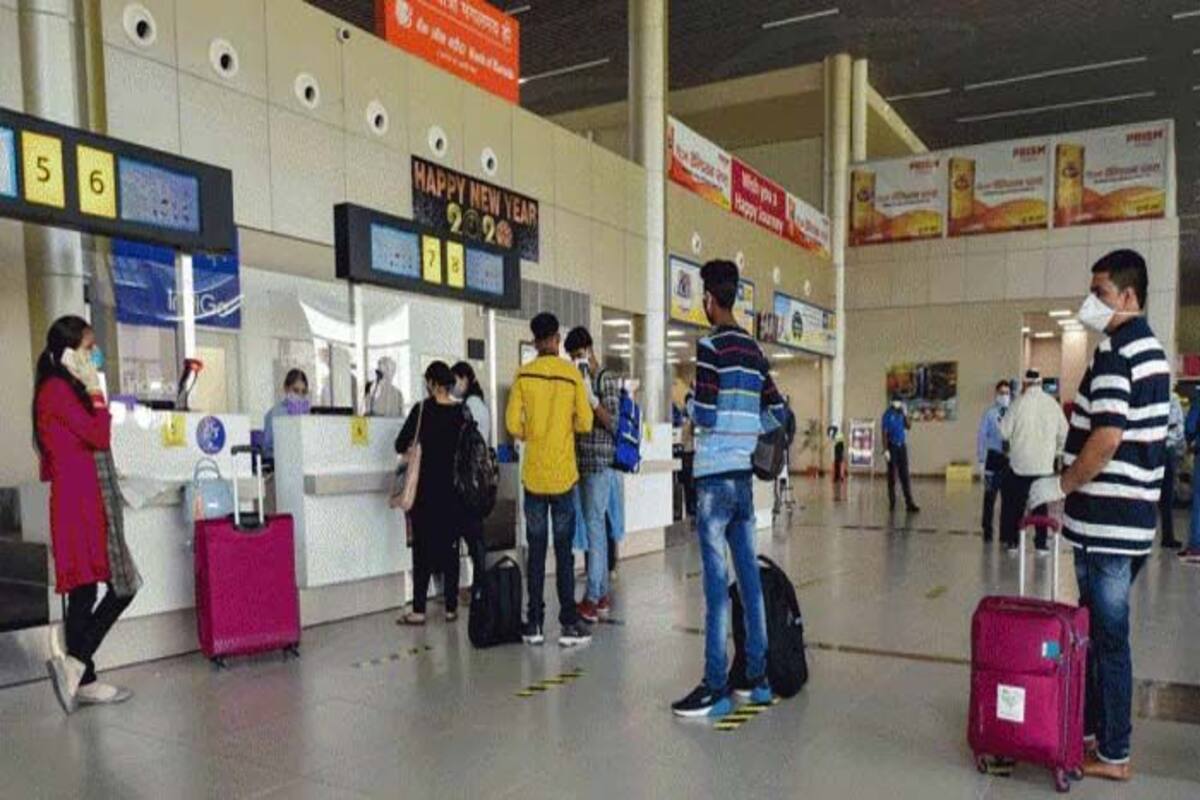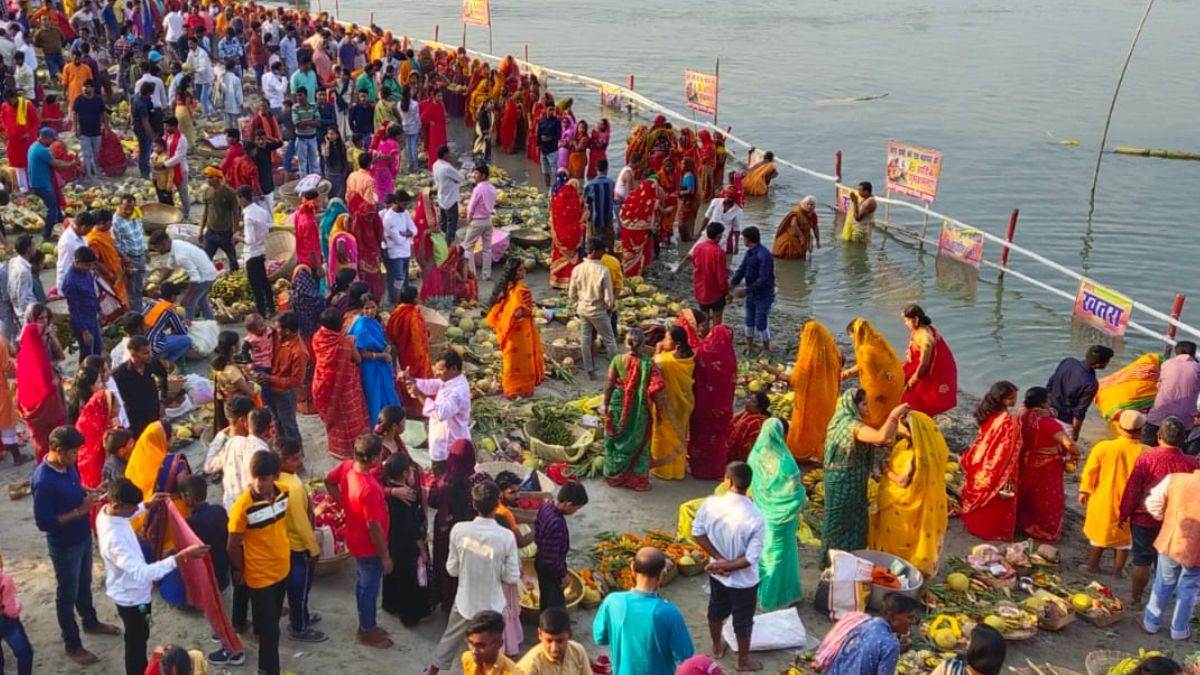Flying Home For Chhath Costs A Staggering ₹18,000—More Than A Trip To Dubai, Leaving Travellers Frustrated!
With Chhath Puja Nearing, Soaring Airfares To Bihar Exceed ₹18,000, Surpassing Dubai Flights, Straining Families And Highlighting The Need For Policy Reforms.

With Chhath Puja around the corner, Bihar-bound travellers have been caught in a rude shock: skyrocketing airline ticket prices. Tickets have been hiking at ₹12,000, ₹13,000 and even up to ₹18,000 for domestic airline journeys to some cities such as Patna and Darbhanga from Delhi and Mumbai, raising eyebrows even over international airfares to Dubai. For many people, the road to celebrating this grounded festival with family members has become a privilege, which brings about frustrations and needs. The increase in fares makes hundreds of thousands of people consider the psychological value of Chhath Puja at home against the dearness of fares, making one come up with travel needs/solutions, particularly during festive seasons.

The Significance of Chhath Puja.
Chhath Puja is celebrated in Bihar, Jharkhand, Uttar Pradesh, and some parts of northeastern Nepal. ‘Kartik Purnima’ is a four-day festival that falls on the fourth day of spring. During this time, people thank ‘Surya Dev’ (The God of the Sun) and ‘Chhathi Maiya’—the goddess of light and energy—for making life on earth possible and granting blessings that include health, wealth, and happiness.
The Vedic origin of this festival is all the more important because, like a few other Hindu festivals, it does not involve the worship of statues. However, it focuses on the worship of nature, more specifically, the sun and water as life force and regeneration symbols. The following are observed: People use the morning and evening to offer ‘Bali,’ fast, and bathe at the river shore, which magnificently depicts a man’s interface with his ecology.
To many, Chhath Puja is not just a religious festival but a time when communities appear to be one. People meet and reunite, which is now widely popular due to labour migration or student exchange programs; this festival is relevant to many individuals. The main points of the ritual – purification and self-denial, as well as unity and togetherness – help make families and communities more united each year.

Chhath Puja also has a concept of purity. Even when celebrating this festival, people usually gather around rivers, and while performing related activities, they have to ensure that the environment remain clean. In the recent past, this aspect has garnered attention because, during the rituals, the devotees ensure the rivers and water bodies are protected during Chhath Puja; hence, this cultural event is also a conservation one.
Over four days, there is abstinence from food and water, prayers to the riversides and pujas are offered, and also to the rising and setting sun- usually by river Ganga or other local water bodies- adding value to the concept of home and participating in Chhath with family members, like a tradition increment in unity and togetherness besides activism of community culture and identity to have enjoyable times.
This gives rise to an even more spectacular social call for travel to return home, with flights to Patna, Gaya, and neighbouring airports being popular among travellers. Many people undertake the journey like a pilgrimage, stressing family and traditional values even though the airfares keep rising to reach home on the Pious occasions of Chhath Puja.
)
In the case of people from Bihar and other nearby states, Chhath is beyond merely a ritual; it is a strong pull of bond that pulls people back to their homes on a festival from the different parts of the country where they are employed or immersing themselves in studies. People from all over India and those living abroad eagerly travel back home to celebrate this festival.
Homeward Bound for Chhath: As Demand Peaks, Flights to Bihar Soar.
During Chhath Puja, there is an excessive rush of people who want to go to Bihar to celebrate Chhath Puja with their family members through Flight bookings. This is particularly the case with flights to Patna, Gay, or other nearby airports, and forms a temporarily high-demand market. Due to this, airlines cope with this period by setting their prices at a high rate in what is referred to as Demand-Based pricing.
Therefore, ticket costs tend to be very high, and a ticket could cost ₹ 13,000 or ₹18,000, sometimes even more than an international flight ticket to Dubai. This technique, referred to as demand-based or surge pricing, is advantageous to the airlines because of the high traffic this season, though highly detrimental to those who may be bereft of faster or other means of getting home. Many travellers know that accommodations for conventional family holidays are somewhat costly, turning attention to expenditures for domestic travel in spark festive periods.

Such differences point to what can be referred to as an inverted price structure, where end consumers pay a significantly higher price for a short domestic flight of a couple of hours maximum. Fares are higher than usual because the demand for air travel in high seasons is too high, and the season’s pricing band is unpredictable.
It becomes much more complicated for the travelling populace heading to Bihar for Chhath Puja as limited outlets offer cheap means. Trains and buses can be affordable. However, all their tickets are sold out weeks before, and often, people have no choice but to take these expensive taxis. This state exemplifies the lack of economic people who have to get financially strained during big festivals to return to their families despite the short distances covered.
Sky-High Chhath Puja Airfares Force Families to Choose Between Tradition and Financial Strain.
High airfare rates were another technical challenge around the time of Chhath Puja, particularly for those with low income since what was initially supposed to be a family reunion suddenly became expensive, too many people from Bihar, Jharkhand, and Uttar Pradesh who work in big cities or other countries, Chhath is an essential tradition to ride home to meet the family and observe traditional rituals.
But a big problem during this period is that flights could be very expensive, making it very difficult for an individual or a family who is already strained for cash to afford the trip. As fares climb to ₹18,000 or more, some travellers face difficult choices: they may be forced to take substantial financial risks to pay for a ticket or forgo critical celebration plans with friends and family.
This situation pressures migrant workers and students, mainly because the latter cannot easily afford such a large budget. The absence of cheap transport services during festivals is disappointing, as families miss commemorative events and momentous occasions. Thus, a cultural event becomes a stressful financial burden for anyone who is unable to travel to be with their families because of these high transport costs.
Limited Flights, High Demand: Chhath Puja Airfare Soars Amid Lack of Fare Regulations.
Why it is hard for travellers to find low-cost airfares to Bihar and other neighbouring states during Chhath Puja involves the following: One big factor is the airline supply, which is constrained. While tier-2 and tier-3 cities such as Patna, Gaya, and Varanasi operate fewer daily flights than the megacities at peak demand times.
While metro cities boast numerous airlines and multiple flights operating daily with large contingency capacities, destinations like Patna and Gaya are blessed with different capacities and routes and have to provide seats as and when the festival rush occurs. Since most airlines’ strategies have shifted towards more lucrative high-volume routes, those serving these cities can charge significantly higher rates during the demand periods since customer options are limited.
There is no legal maximum for domestic airline prices during peak festival time, which means the price can increase. Although some state governments have requested fare caps, no central guidelines exist. Many travellers find the costs expensive, with share prices sometimes soaring even higher than international fares. This puts additional financial pressure on people looking to return to their hometowns for festivals like Chhath Puja.
Fare Caps and Increased Flights: Policy Solutions to Make Festival Travel More Affordable.
Recently, the government has been pressured to subsidise domestic airlines and slash fares during occasions like Chhath Puja when the favourite but under-supply routes have a considerable demand. Set fare caps and reduce or eliminate fares at peak travel times, when families are getting squeezed together only to have their wallets emptied.
Add More Options: Some tier-2 and tier-3 cities operate with just 1 flight daily. Looking at Sky, which has limited capacity, won’t lead to an increase in the number of flights. If the frequency of flights is increased to more cities, then the remaining pressure can also be averted. It could help relieve capacity constraints that are especially acute between point A and point F during peak times, which could open up new alternatives for travellers in this century. Even domestic fares can help by not gouging travellers—fairs to culturally important destinations should be reasonably priced, and airlines must also be part of the solution.
Thus, government authorities can help airlines by improving the availability of additional flight options and fare structures. This could eliminate costly fares that deny families of lower income brackets an opportunity to fly home during festivities. With affordable rates, the challenges of domestic travel become manageable; people can fund their customs and celebrate with loved ones without feeling financially burdened.
The affected travellers usually belong to the low-income group, as they find it difficult to get seats on the available trains or buses. As a result, most of them travel for extra hours and days to reach their destinations. This comes from the hardships a traveller faces, including high airfare during the festival seasons, making it impossible for them to get to their close family members at such times physically and financially.

The high fares of Bihar and neighbouring states during Chhath Puja symbolise society’s problems when families try to reunite for this beautiful occasion. Higher charges also make it unbearable for people to travel, and in a quest for cheaper means, risks are taken, such as travelling in crowded trains and long bus trips. These measures come with many psychological barriers.
With families struggling hard to honour traditions and join their loved ones, reforms in the aviation sector policy have become more pressing than ever before. Implementing fare caps and increasing the flight frequency to underserved regions would alleviate the financial burden on travellers and make the cultures accessible to all sections. In the following ways, there are chances that airlines and policy-makers can facilitate a balanced travel landscape where the holy spirit of Chhath Puja could flourish rather than being haunted by heavy prohibitions.





